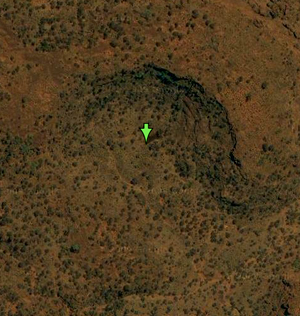
Duane Hamacher, an astrophysicist studying Aboriginal astronomy at Sydney's Macquarie University, used Google Maps to search for the signs of impact craters in areas related to Aboriginal stories of stars or stones falling from the sky.
One story, from the folklore of the Arrernte people, is about a star falling to Earth at a site called Puka. This led to a search on Google Maps of Palm Valley, about 130 km southwest of Alice Springs. Here Hamacher discovered what looked like a crater, which he confirmed with surveys in the field in September 2009.
Cosmic impact
The crater is 280 m in diameter and about 30 m deep. Magnetic and gravitational data collected from the site show the crater is bowl-shaped below the surface and was likely caused by a meteorite a few metres in diameter.
"There is no other way to explain this than as a cosmic impact," said Hamacher. "It couldn't have been erosion and there is no volcanic activity in the area."
Macquarie University co-worker, Craig O'Neill, added that a tiny amount of 'shocked quartz' had also been found at the site. "These were very rare, but only form if a rock has experienced a shock blast like that from a nuclear bomb or meteorite impact," he said.
The research is described in papers Hamacher is preparing for submission to the journals Archaeoastronomy and Meteoritics and Planetary Science.
Crater spotting
Despite the link to the Dreaming story, weathering and the absence of meteorite fragments suggest that the crater is millions of years old and humans could not possibly have witnessed the event, Hamacher said.
Another crater at Gosse's Bluff, 170 km west of Alice Springs, is 140 million years old, and is also the subject of an Arrernte Dreaming story about a "cosmic baby" which fell to Earth.
Instead, Hamacher thinks Arrernte Aborigines may have learned to recognise craters from more recent impacts and then deduced the origin of the Palm Valley and Gosse's Bluff craters. One more recent example of craters created by an impact are the Henbury craters, 70 km from Palm Valley and just 4,000 years old.
He noted that his theory is speculation and the presence of the Palm Valley crater near to the origin of the Arrernte story could simply be a coincidence.
Hamacher's comparison of known craters and Aboriginal stories about cosmic impacts have not yet uncovered conclusive evidence that meteorite impacts have been witnessed and incorporated into oral tradition.
But he has found documented evidence of the Henbury craters being referred to as "chindu china waru chingi yabu" by Aboriginal elders, which he said roughly translates as "Sun walk fire devil rock".
Sacred stories
The Parks and Wildlife Commission of the Northern Territory notes in its 2002 management plan for the Henbury craters, that it is aware of related mythologies, but cannot share them, because they are considered sacred and secret by the Aboriginal custodians of the site.
Hamacher said that he thinks it is possible that a direct link will be found and that further research into Dreaming stories could help uncover new meteorite impact sites. He hopes to return to the area to talk to Aboriginal elders about their stories.



Reader Comments
to our Newsletter